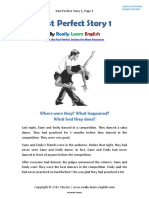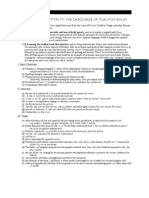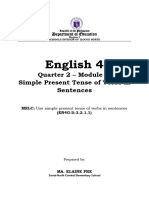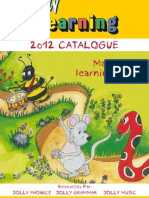Guided Learning Activity Kit - English 4 - Tomelden
Guided Learning Activity Kit - English 4 - Tomelden
Uploaded by
CHARMIN RHODA TOMELDENCopyright:
Available Formats
Guided Learning Activity Kit - English 4 - Tomelden
Guided Learning Activity Kit - English 4 - Tomelden
Uploaded by
CHARMIN RHODA TOMELDENOriginal Description:
Original Title
Copyright
Available Formats
Share this document
Did you find this document useful?
Is this content inappropriate?
Copyright:
Available Formats
Guided Learning Activity Kit - English 4 - Tomelden
Guided Learning Activity Kit - English 4 - Tomelden
Uploaded by
CHARMIN RHODA TOMELDENCopyright:
Available Formats
4 Republic of the Philippines
Department of Education
REGION III-CENTRAL LUZON
SCHOOLS DIVISION OF ZAMBALES
LONGOS ELEMENTARY SCHOOL
LONGOS, CABANGAN, ZAMBALES
ENGLISH
Guided Learning Activity Kit
Composing Clear and Coherent
Sentences using Appropriate
Grammatical Structures
(verb tenses)
Quarter 2 -Week 6-8
Longos Integrated School
National Highway, Longos, Cabangan, Zambales
501302@deped.gov.ph
Composing Clear and Coherent
Sentences using Appropriate
Grammatical Structures
(verb tenses)
Introduction
In your previous grades in school, you are taught that verb are action
words used to provide details of what a subject is doing as described within sentences.
You also learned how to use appropriate grammatical structures to write a more
coherent ideas and sentences with the help of subject and verb agreement.
Singular nouns or subjects must have singular verbs as well as plural
nouns having plural verbs but suggests the opposite when we use a present tense. A
dog chases the mailman for example, has one noun and added to the verb ‘chase’ is ‘-
s’.
In this Guided Learning Activity Kit, we are going to enjoy composing clear
and coherent sentences using appropriate grammatical structures in verb tenses.
Happy learning!
Learning Competency
Compose clear and coherent sentences using appropriate grammatical
structures (verb tenses) EN4G-Ii-3.2.1.1, EN4G-IIf-10, EN4G-IIi-12.
Objectives
At the end of this Guided Learning Activity Kit, you are expected to:
Longos Integrated School
National Highway, Longos, Cabangan, Zambales
501302@deped.gov.ph
1. distinguish past tense, present tense and future tense verbs from one another;
2. choose appropriate verb tenses to be used in the given sentences and;
3. compose clear and coherent sentences using appropriate grammatical structures
(verb tenses).
Review
Directions: Identify the elements of the short narrative below and
summarize it based on its elements. Do this in a separate sheet of paper.
The Magic Window
Once upon a time there was a little boy who became very ill. He had to spend
all day in bed, unable to move. Because other children weren't allowed to come
near him, he suffered greatly, and spent his days feeling sad and blue.
There wasn't much he could do except look out of the window. Time passed,
and his feeling of despair just grew. Until one day he saw a strange shape in the
window. It was a penguin eating a sausage sandwich. The penguin squeezed in
through the open window, said "Good afternoon" to the boy, turned around, and
left again.
Of course, the boy was very surprised. He was still trying to work out what had
happened, when outside his window he saw a monkey in a nappy, busy blowing
up a balloon. At first the boy asked himself what that could possibly be, but after
a while, as more and more crazy-looking characters appeared out the window, he
burst out laughing and found it hard to stop.
Anyone wanting to stop laughing would never be helped by seeing a pig playing
a tambourine, an elephant jumping on a trampoline, or a dog wearing a pair of
glasses and talking about nothing except politics. The little boy didn't tell anyone
about this because who would have believed him? Even so, those strange
characters ended up putting joy back in his heart, and in his body. Before long,
his health had improved so much that he was able to go back to school again.
There he got to talk to his friends and tell them all the strange things he had
seen. While he was talking to his best friend he saw something sticking out of his
friend's school bag. The boy asked his friend what it was, and he was so insistent
that finally his friend had to show him what was in the bag:
There, inside, were all the fancy-dress suits and disguises that his best friend
had been using to try to cheer the little boy up!
And from that day on, the little boy always did his best to make sure that no
one felt sad and alone.
Longos Integrated School
National Highway, Longos, Cabangan, Zambales
501302@deped.gov.ph
Discussion
Well done! You finished the task easily. Now, we know that you are
ready for the next lesson, learning verb tenses and how and when to use them.
Let us study and analyze the picture below.
What can you see in the picture? What does it say?
Now, let’s look at the picture below. What do you think are the formed
words below? What does each of them means?
Longos Integrated School
National Highway, Longos, Cabangan, Zambales
501302@deped.gov.ph
A verb is a word or a combination of words that indicates action or a state of being
or condition. A verb is the part of a sentence that tells us what the subject performs.
Throw and catch are example
of action words as well as 3I
sleep, walk, run, sit, fetch and
stretch.
Tenses of verb however, are associated with time of when the action is performed.
In the first picture, we can see a boy, an adult and an old man with captions past,
present and future. While in the second picture, we can see words such as eat with
additional letters ‘-s’, ‘-en’ and ‘-ing which makes the verb ‘eat’ emphasize the time of its
execution. Another word in the picture is ‘ate’ which means the subject is done on what
he/she was doing.
Verb tenses are not only for action words but also for linking verbs (is/was and
are/were).
There are three main verb tenses.
1. Past Tense
2. Present Tense
3. Future Tense
Past tense is a verb tense used for a past activity or a past state of being.
For example:I jumped in the bridge. (past activity)
I was happy. (past state of being)
Present tense is a grammatical tense whose principal function is to locate a
situation or event in the present time. The present tense is used for actions which are
happening now.
For example: I drink eight glasses of water every day. (current activity)
I am glad to see you here. (present state of being)
Future tense is a verb tense used for a future activity or a future state of being.
For example: I will call you when I get home. (future activity)
I will be happy to meet you there. (future state of being)
Longos Integrated School
National Highway, Longos, Cabangan, Zambales
501302@deped.gov.ph
Another term that you should remember is participle. It is a verb form that can be
used as an adjective, to create verb tense, or to create the passive voice. There are two
types of participles: Present participle (ending -ing) Past participle (usually ending -ed,
-d, -t, -en, or -n).
Activities
Guided Practice 1
Directions: Determine if the underlined verb is in past tense, present tense or future
tense. Write PAST if it is in past tense, PRESENT if it is in present tense and FUTURE
if in future tense.
_________1. During a movie, John stood up and dropped his popcorn.
_________2. Jim walks out the room after hearing the bad news.
_________3. She catches the ball and throws it to the catcher.
_________4. I was drinking soda when he made a joke.
_________5. He said he will wash the dishes after one more game.
Good work! You were been very good in this activity. I believe you will easily get this
next task.
Guided Practice 2
Directions: Complete the table below by writing what is the appropriate verb tenses
or participle for each missing item.
Item Base Form Past Tense Present Tense Future Tense
1 catch caught will catch
2 drive driving will drive
3 sang singing will sing
4 go going will go
5 leave left leaving
6 eat ate will eat
7 break breaking will break
8 see saw will see
9 comb combed will comb
10 say saying will say
Longos Integrated School
National Highway, Longos, Cabangan, Zambales
501302@deped.gov.ph
Congratulations! You did great! You are now ready for an independent activity. I
know you can do this by yourself. Are you excited for the task?
Independent Practice
Direction: Find at least five action words in the text below. List it down and identify the5 I
past and future tense of each action word.
My Best Teacher
Teachers are the ones who build a good nation and
make the world a better place. My best teacher is called
Robert. He teaches us English. I admire him because
he is well-prepared in advance for our lessons. He is
like a friend that helps us and encourages us to do our
best to achieve our goals. I like his subject because he
gives us the chance to excel without putting too much
pressure on us.
For example: teaches – taught (past), will teach (future)
1. _______________ - _________________, _________________
2. _______________ - _________________, _________________
3. _______________ - _________________, _________________
4. _______________ - _________________, _________________
5. _______________ - _________________, _________________
Assessment
Directions: Identify the base form of the verb shown in the pictures
below and write a sentence in past tense, present tense and future tense using these
words.
For example: Base Form of the Verb: Brush
Past Tense: I brushed my teeth this morning.
Present Tense: I am brushing my teeth right now.
Longos Integrated School
National Highway, Longos, Cabangan, Zambales
501302@deped.gov.ph
Future Tense: I will brush my teeth after eating dinner.
Base Form of the Verb: __________
Past Tense: _____________________________
Present Tense: _______________________________
Future Tense: _____________________________
1.
Base Form of the Verb: __________
Past Tense: _____________________________
Present Tense: _______________________________
Future Tense: _____________________________
2.
Base Form of the Verb: __________
Past Tense: _____________________________
Present Tense: _______________________________
Future Tense: _____________________________
3.
Base Form of the Verb: __________
Past Tense: _____________________________
Present Tense: _______________________________
Future Tense: _____________________________
4.
Base Form of the Verb: __________
Past Tense: _____________________________
Present Tense: _______________________________
Future Tense: _____________________________
5.
Longos Integrated School
National Highway, Longos, Cabangan, Zambales
501302@deped.gov.ph
Reflection
You did it! You had been so patient and eager in accomplishing your7 I
Guided Learning Activity Kit. This time I would like to know if you were able to learn,
acquire and perhaps master the competency required of you in this Learning Kit.
Directions: Write a short essay about how you are keeping yourself busy and safe
during the lockdown period. Use past verb tenses as you narrate your experiences in
the past months. You can also use present verb tenses in describing what makes you
enjoy online classes and future verb tenses in sharing what will you do after the
lockdown.
___________________________________________________________________
___________________________________________________________________
___________________________________________________________________
___________________________________________________________________
___________________________________________________________________
___________________________________________________________________
___________________________________________________________________
___________________________________________________________________
___________________________________________________________________
___________________________________________________________________
___________________________________________________________________
___________________________________________________________________
___________________________________________________________________
___________________________________________________________________
___________________________________________________________________
___________________________________________________________________
___________________________________________________________________
___________________________________________________________________
Longos Integrated School
National Highway, Longos, Cabangan, Zambales
501302@deped.gov.ph
References
The magic window https://freestoriesforkids.com/children/stories-and-tales/magic-
window
https://www.learngrammar.net/english-grammar/verb
Present Tense https://www.grammar-monster.com/glossary/present_tense.htm
Future Tense https://www.grammar-monster.com/glossary/future_tense.htm
FB group (worksheets Pdf), My best teacher
https://www.facebook.com/groups/528128017744525/permalink/85540646835001
0/?app=fbl
What Are Participles? (with Examples) https://www.grammar-
monster.com/glossary/participles.htm#:~:text=A%20participle%20is%20a%20verb,en
%2C%20or%20%2Dn)
Past tense https://en.wikipedia.org/wiki/Past_tense
https://www.grammar-monster.com/glossary/past_tense.htm
Images
https://www.google.com/search?q=children+reading+clipart&tbm=isch&ved=2ahUKE
wj05Z-D6LjvAhVL7ZQKHcm3DE8Q2-
cCegQIABAA&oq=children+reading+clipart&gs_lcp=CgNpbWcQAzICCAAyAggAMgIIADI
CCAAyAggAMgIIADICCAAyAggAMgIIADoGCAAQBxAeUPeDDlipkQ5glpMOaABwAHgAg
AGIBIgBrRSSAQcyLTcuNS0ymAEAoAEBqgELZ3dzLXdpei1pbWfAAQE&sclient=img&ei
=Q71SYLS4Acva0wTJ77L4BA&bih=657&biw=1366&hl=en#imgrc=Pkp2_or96Lcr_M
https://www.google.com/search?q=children+in+uniform+learning+clipart&tbm=isch&
ved=2ahUKEwjs-MX457jvAhUEAaYKHQhADI8Q2-
cCegQIABAA&oq=children+in+uniform+learning+clipart&gs_lcp=CgNpbWcQAzoICAAQ
CBAHEB46BggAEAgQHlCPMVjqU2CCVWgAcAB4AIABqQKIAewPkgEFMC43LjOYAQCg
AQGqAQtnd3Mtd2l6LWltZ8ABAQ&sclient=img&ei=LL1SYOyyI4SCmAWIgLH4CA&bih=
657&biw=1366&hl=en#imgrc=qO_Ul1Ody2TlgM&imgdii=FkC-D28BNX3zMM
https://www.google.com/search?q=children+playing+sport+clipart&tbm=isch&ved=2a
hUKEwiJ6Oyu6bjvAhUTgpQKHaqxCgQQ2-
cCegQIABAA&oq=children+playing+sport+clipart&gs_lcp=CgNpbWcQAzICCAA6BggAE
AcQHlCBGFilJWC1J2gAcAB4AIABnwOIAaQMkgEJMC4xLjQuMC4xmAEAoAEBqgELZ3
dzLXdpei1pbWfAAQE&sclient=img&ei=qr5SYInrNpOE0gSq46og&bih=657&biw=1366&
hl=en#imgrc=qh0JAM9EtkHbGM
https://www.google.com/search?q=children+making+art+clipart&tbm=isch&ved=2ah
UKEwjHoemy6bjvAhURNaYKHToNCEgQ2-
cCegQIABAA&oq=children+mak+clipart&gs_lcp=CgNpbWcQARgCMgYIABAHEB4yBggA
EAcQHjIGCAAQBxAeMgYIABAHEB4yBggAEAcQHjIGCAAQBxAeMgYIABAHEB4yBggAE
AcQHjIGCAAQBxAeULy-
CliowwpgzOIKaABwAHgAgAHyBIgBmQ2SAQczLTMuMC4xmAEAoAEBqgELZ3dzLXdpei
Longos Integrated School
National Highway, Longos, Cabangan, Zambales
501302@deped.gov.ph
1pbWfAAQE&sclient=img&ei=s75SYIf8DZHqmAW6mqDABA&bih=657&biw=1366&hl=
en#imgrc=w5IWFYQ4qv_6QM
https://www.google.com/search?q=verb+tenses&bih=657&biw=1366&hl=en&source=l
nms&tbm=isch#imgrc=gOa3eSRlXwtN8M
https://www.google.com/search?q=verb+tenses&bih=657&biw=1366&hl=en&source=l
nms&tbm=isch#imgrc=idXcMvbZxE9mcM
https://www.google.com/search?q=references+icon&tbm=isch&ved=2ahUKEwi2ksGQ
7LbvAhX0JqYKHTmxBDQQ2-
cCegQIABAA&oq=references+icon&gs_lcp=CgNpbWcQA1Cl5TBY1PAwYPXxMGgAcAB4
AYABqwSIAdUUkgEJMi0yLjIuMi4xmAEAoAEBqgELZ3dzLXdpei1pbWfAAQE&sclient=i
mg&ei=IbVRYPb9BfTNmAW54pKgAw&bih=657&biw=1366&hl=en#imgrc=dlIaEGMFs9
m9nM
https://www.google.com/search?q=reflection+ison&tbm=isch&ved=2ahUKEwiPu9S-
6LbvAhXJAaYKHZAVAxcQ2-
cCegQIABAA&oq=reflection+ison&gs_lcp=CgNpbWcQAzIHCAAQsQMQQzIECAAQQzIEC
AAQQzIECAAQQzIFCAAQsQMyCAgAELEDEIMBMgcIABCxAxBDMgQIABBDMggIABCx
AxCDATIICAAQsQMQgwE6AggAUIKBO1ihmDtgvZs7aABwAHgAgAHKBIgB0xaSAQswLj
EuNC4xLjIuMZgBAKABAaoBC2d3cy13aXotaW1nwAEB&sclient=img&ei=ULFRYI_TCM
mDmAWQq4y4AQ&bih=657&biw=1366&hl=en#imgrc=2NIkdObs-F3jFM
https://www.google.com/search?q=action+word&tbm=isch&hl=en&chips=q:action+wo
rd,g_1:clipart:PO5iGRQi6Bk%3D&bih=657&biw=1366&sa=X&ved=2ahUKEwjuv7286L
bvAhWqG6YKHSZTB7IQ4lYoAXoECAEQGw#imgrc=HyzZiO3ykLa64M
https://www.google.com/search?q=action+word&tbm=isch&hl=en&chips=q:action+wo
rd,g_1:clipart:PO5iGRQi6Bk%3D&bih=657&biw=1366&sa=X&ved=2ahUKEwjuv7286L
bvAhWqG6YKHSZTB7IQ4lYoAXoECAEQGw#imgrc=3SFzM6UFYPhq7M
https://www.google.com/search?q=action+word&tbm=isch&hl=en&chips=q:action+wo
rd,g_1:clipart:PO5iGRQi6Bk%3D&bih=657&biw=1366&sa=X&ved=2ahUKEwjuv7286L
bvAhWqG6YKHSZTB7IQ4lYoAXoECAEQGw#imgrc=ikfKgEsQSS1D-M
https://www.google.com/search?q=action+word&tbm=isch&hl=en&chips=q:action+wo
rd,g_1:clipart:PO5iGRQi6Bk%3D&bih=657&biw=1366&sa=X&ved=2ahUKEwjuv7286L
bvAhWqG6YKHSZTB7IQ4lYoAXoECAEQGw#imgrc=wAGu5yBtitXFXM
https://www.google.com/search?q=action+word&tbm=isch&hl=en&chips=q:action+wo
rd,g_1:clipart:PO5iGRQi6Bk%3D&bih=657&biw=1366&sa=X&ved=2ahUKEwjuv7286L
bvAhWqG6YKHSZTB7IQ4lYoAXoECAEQGw#imgrc=3IY5vkb9-jdY8M
https://www.google.com/search?q=action+word&tbm=isch&hl=en&chips=q:action+wo
rd,g_1:clipart:PO5iGRQi6Bk%3D&bih=657&biw=1366&sa=X&ved=2ahUKEwjuv7286L
bvAhWqG6YKHSZTB7IQ4lYoAXoECAEQGw#imgrc=-QdhiSqmaMjb4M
https://www.google.com/search?q=assessment+circle+icon&hl=en&source=lnms&tbm
=isch&biw=1366&bih=657#imgrc=e2zgn43Opuux1M
https://www.google.com/search?q=english+teacher+male+clipart&tbm=isch&ved=2ah
UKEwi08Pbd4bbvAhVTAaYKHakEDFUQ2-
cCegQIABAA&oq=english+teacher+male+clipart&gs_lcp=CgNpbWcQAzIGCAAQCBAeOg
IIADoGCAAQBRAeULpRWPWSAWCylQFoAHAAeAGAAcQEiAH_H5IBCzAuNC44LjEuMS
4xmAEAoAEBqgELZ3dzLXdpei1pbWfAAQE&sclient=img&ei=OqpRYLTrKNOCmAWpib
CoBQ&bih=657&biw=1366&hl=en#imgrc=fG8a6ayUlcJe0M
Longos Integrated School
National Highway, Longos, Cabangan, Zambales
501302@deped.gov.ph
501302@deped.gov.ph
National Highway, Longos, Cabangan, Zambales
Longos Integrated School
Independent Practice Review
Any of the following: Characters, setting, plot,
Build – built (past), will build conflict/problem and resolution
(future) (Answers may vary for the
Make – made (past), will make summary)
(future)
Admire – admired (past), will admire Guided Practice 1
(future) 1. PAST
Helps – helped (past), will help 2. PRESENT
(future) 3. PRESENT
Encourages – encouraged (past), will 4. PAST
encourage (future) 5. FUTURE
Achieve – achieved (past), will
achieve (future) Guided Practice 2
Gives – gave (past), will give (future) 1. Catching
Putting – put (past), will put (future) 2. Drove
3. Sing
4. Went
Reflection 5. Will leave
(Answers may vary) 6. Eating
7. Broke
8. Seeing
9. Combing
10.Said
Assessment
Base Form of the Verb
1. Skip
2. Cook
3. Count
4. Sweep
5. Dance
(Answers may vary for the
sentences)
Key to Corrections
Acknowledgment
I would like to express my heartfelt gratitude to the following, who in one way or
the other, have contributed to the successful preparation, development, quality
assurance, printing, and distribution of the Quarter 4 Guided Learning Activity Kits
(GLAK) as a response to providing the learners with developmentally appropriate,
contextualized and simplified learning resources with most essential learning
competencies (MELCs)-based activities anchored on the principles of guided learning
and explicit instruction:
First, my School Head, Jonathan N. Mallari for his continuous encouragement and
unwavering support for the completion of this GLAK.
Second, the layout artist, my daughter, Pat Rych C. Tomelden for helping me in
making this Guided Learning Activity Kits (GLAK).
Third , the parents and other home learning facilitators for giving the learners the
needed guidance and support for them to possibly accomplish the tasks and for
gradually helping them become independent learners.
Finally, God and my family who served as my inspiration to deliver learning
continuity in this challenging circumstance to serving our Longos Integrated School
learners.
Thank you very much!
Submitted by:
CHARMIN RHODA C. TOMELDEN
Teacher II
Noted:
JONATHAN N. MALLARI
School Principal II
Longos Integrated School
National Highway, Longos, Cabangan, Zambales
501302@deped.gov.ph
You might also like
- FPSC Inspector Customs Intelligence Officer TestDocument7 pagesFPSC Inspector Customs Intelligence Officer Testyusha habibNo ratings yet
- English 3 Quarter 2 Week 2 Lesson 1 2 3Document32 pagesEnglish 3 Quarter 2 Week 2 Lesson 1 2 3Joshwa heromo100% (2)
- English 3 Quarter 2 Week 2 Simple Tenses of VerbsDocument69 pagesEnglish 3 Quarter 2 Week 2 Simple Tenses of VerbsRovi Chell100% (4)
- Past Perfect Reading ComprehensionDocument4 pagesPast Perfect Reading ComprehensionJuliana Guerrero100% (3)
- Yolanda Soryl PhonicsDocument10 pagesYolanda Soryl Phonicsapi-444974693No ratings yet
- Language PlautusDocument2 pagesLanguage PlautusLa Rañoula100% (1)
- Clauses - English SyntaxDocument15 pagesClauses - English SyntaxSanja Miketić Subotić0% (1)
- English 4 Q2 M5 Week5 MELC05 Simple Present Tense of Verbs - MaElainePre - FINALDocument11 pagesEnglish 4 Q2 M5 Week5 MELC05 Simple Present Tense of Verbs - MaElainePre - FINALLaine RepNo ratings yet
- English6 q4 Week1 v4Document8 pagesEnglish6 q4 Week1 v4Corazon Diong Sugabo-TaculodNo ratings yet
- Pancit CantonDocument7 pagesPancit Cantonjohnjoshua cambalizaNo ratings yet
- Trabalho de InglesDocument18 pagesTrabalho de InglesSabio Maria JulioNo ratings yet
- Basic English Communcation Skills (GRAMMAR)Document9 pagesBasic English Communcation Skills (GRAMMAR)Paige PHNo ratings yet
- G9 - Intervention Material - Post Test - 1st Quarter - Be Verbs EditedDocument4 pagesG9 - Intervention Material - Post Test - 1st Quarter - Be Verbs EditedRalph Bagunas RamonesNo ratings yet
- SLK No. 2 IlocosDocument12 pagesSLK No. 2 IlocosSander S. UtreraNo ratings yet
- English 6 - Q2 - M5Document15 pagesEnglish 6 - Q2 - M5Cheeny De GuzmanNo ratings yet
- English 5 Q2 V2Document32 pagesEnglish 5 Q2 V2YOHANNA SOLENN RILLONo ratings yet
- English 6 Quarter 4Document9 pagesEnglish 6 Quarter 4baldo yellow4100% (3)
- English: Fourth Quarter-SIM 6.4.1 Lesson 4Document14 pagesEnglish: Fourth Quarter-SIM 6.4.1 Lesson 4Jeff FroxNo ratings yet
- English: Quarter 2 - Module 2 Lesson 1-3Document27 pagesEnglish: Quarter 2 - Module 2 Lesson 1-3Pia JalandoniNo ratings yet
- Language FocusDocument16 pagesLanguage FocusOlaybar Eso50% (2)
- 3900 Differentiated Lesson PlanDocument7 pages3900 Differentiated Lesson Planapi-247228121No ratings yet
- Teaching English To Young LearnersDocument16 pagesTeaching English To Young Learnerszbuseyagmur19No ratings yet
- Q2W3 Eng5 q2w3 Mod1 Les3 Conjunctions-1Document22 pagesQ2W3 Eng5 q2w3 Mod1 Les3 Conjunctions-1Adlai CastroNo ratings yet
- Eng 5 - Q2 - Module 1 - L1 Aspects of VerbDocument11 pagesEng 5 - Q2 - Module 1 - L1 Aspects of VerbAnonymous gV9BmXXHNo ratings yet
- English Grade 5 Q2 Weeks 1-4Document41 pagesEnglish Grade 5 Q2 Weeks 1-4ryedenemmanuel.glorianeNo ratings yet
- GN 3 - 3 2020 1 VMBGDocument9 pagesGN 3 - 3 2020 1 VMBGAstrid M. Sandoval BautistaNo ratings yet
- Conjunctions 1Document50 pagesConjunctions 1Shanelle May G. CasabuenaNo ratings yet
- Q4week3englishday1-5 FINALDocument91 pagesQ4week3englishday1-5 FINALDronio Arao L-saNo ratings yet
- Week 5 6Document31 pagesWeek 5 6IRISH ANNE MARAMAGNo ratings yet
- English7 q1 Mod7of8 Phrases v2Document24 pagesEnglish7 q1 Mod7of8 Phrases v2sofia grace antonio100% (1)
- English 7 Las Quarter 3 Week2Document7 pagesEnglish 7 Las Quarter 3 Week2Reñer Aquino BystanderNo ratings yet
- English 3 Quarter 2 Week 2 Simple Tenses of VerbsDocument69 pagesEnglish 3 Quarter 2 Week 2 Simple Tenses of VerbsMel VillafloresNo ratings yet
- Estánder: Estrategia:: Al Finalizar La Actividad El Estudiante Es Capaz de Expresar en 3Document2 pagesEstánder: Estrategia:: Al Finalizar La Actividad El Estudiante Es Capaz de Expresar en 3Yampier Parra SuarezNo ratings yet
- English 7 - Q1 - M9Document11 pagesEnglish 7 - Q1 - M9Vanessa Mae GaringaNo ratings yet
- Q3 English 3 Module 4Document18 pagesQ3 English 3 Module 4shyne elonaNo ratings yet
- English 6 Reading EnhancementDocument26 pagesEnglish 6 Reading Enhancementissiajay.pontillasNo ratings yet
- Module in VerbsDocument14 pagesModule in VerbsRisha Vee Argete Tutor100% (1)
- Simple Tenses: Will WalkDocument6 pagesSimple Tenses: Will WalkDoc AlexNo ratings yet
- DLP Day 2 Week 5 - English 4 Quarter 1Document6 pagesDLP Day 2 Week 5 - English 4 Quarter 1Monica CuerdoNo ratings yet
- Lesson Plan in Structure of EnglishDocument5 pagesLesson Plan in Structure of Englishff4yh7x558No ratings yet
- DETAILED LESSON PLAN IN ENGLISH 5 Present TenseDocument4 pagesDETAILED LESSON PLAN IN ENGLISH 5 Present TenseKrizzia Bano100% (1)
- ENG 10 Revised NextGen Blended LM T1 15-16Document14 pagesENG 10 Revised NextGen Blended LM T1 15-16Ramon GasgasNo ratings yet
- INSTITUTO TECNICO CULTURAL DIOCESANO Guia 2Document6 pagesINSTITUTO TECNICO CULTURAL DIOCESANO Guia 2Kelly CastroNo ratings yet
- EN2 - Q2 - Module 7Document11 pagesEN2 - Q2 - Module 7Kaye OleaNo ratings yet
- English5-PPT Q2Document90 pagesEnglish5-PPT Q2Maria Carmina PanghulanNo ratings yet
- English-5-Q2-Module-1-Lesson-1-ASPECTS of VERBSDocument17 pagesEnglish-5-Q2-Module-1-Lesson-1-ASPECTS of VERBSLaine RepNo ratings yet
- ENG3 - Q2 - M6 - Words With Initial and Final Consonant BlendsDocument25 pagesENG3 - Q2 - M6 - Words With Initial and Final Consonant Blendss.gilbero.125195.tcNo ratings yet
- The Verb: Recognize A Verb When You See OneDocument11 pagesThe Verb: Recognize A Verb When You See OneAhmad Faiz AbdullahNo ratings yet
- ENGLISH 5 - Q2 - Mod1Document14 pagesENGLISH 5 - Q2 - Mod1Vhalerie May100% (1)
- Review of VERBS For CaretakersDocument3 pagesReview of VERBS For CaretakersKimberly Corsentino KeyworthNo ratings yet
- SLK Eng2 q1wk5Document15 pagesSLK Eng2 q1wk5Ma Adele Fe ManulatNo ratings yet
- Quarter 2: Week 6Document23 pagesQuarter 2: Week 6ELAINE ARCANGELNo ratings yet
- Emergent LessonDocument5 pagesEmergent Lessonapi-314454697No ratings yet
- Module OneDocument17 pagesModule OneHyoun Ji SeoNo ratings yet
- Tasks AprilDocument12 pagesTasks Aprilanon_894272823No ratings yet
- SIM-6 4 6-v5Document18 pagesSIM-6 4 6-v5Lyn Myling Lopio-LigueNo ratings yet
- ENG3 - Q2 - M6 - Words With Initial and Final Consonant BlendsDocument24 pagesENG3 - Q2 - M6 - Words With Initial and Final Consonant Blendss.gilbero.125195.tcNo ratings yet
- Text Talk Lesson PlanDocument6 pagesText Talk Lesson Planapi-270743490100% (2)
- Week 1 GrammarDocument22 pagesWeek 1 GrammarFox MantisNo ratings yet
- English 3: Super Sentences!Document21 pagesEnglish 3: Super Sentences!Jerald Jay Capistrano CatacutanNo ratings yet
- Present Simple Vs Present Continuous Exercise 1Document4 pagesPresent Simple Vs Present Continuous Exercise 1Marta ZrnNo ratings yet
- Word Power 1-ALSDocument29 pagesWord Power 1-ALSSofia86% (7)
- The Cape Verdean Creole of São VicenteDocument302 pagesThe Cape Verdean Creole of São VicenteSamuel EkpoNo ratings yet
- Lesson 1 NOUNSDocument32 pagesLesson 1 NOUNSJade Berlyn AgcaoiliNo ratings yet
- Class 6 Annual Assessment 22-23 PortionDocument5 pagesClass 6 Annual Assessment 22-23 PortionAnanya GourishettyNo ratings yet
- Unit 1Document7 pagesUnit 1Cristina GarciaNo ratings yet
- Uk Catalogue Web 2012Document28 pagesUk Catalogue Web 2012api-154406899No ratings yet
- Communicative Competence of Grade 11 Learners of Libon-Agro Industrial High SchoolDocument46 pagesCommunicative Competence of Grade 11 Learners of Libon-Agro Industrial High SchoolNolan G. SerranoNo ratings yet
- P OWERPOINTDocument41 pagesP OWERPOINTRechelle CapunoNo ratings yet
- Rules To Convert Active Voice Into Passive VoiceDocument8 pagesRules To Convert Active Voice Into Passive Voicereyazuddinansari00786No ratings yet
- Auxiliary Verbs QuizDocument3 pagesAuxiliary Verbs QuizFreya SawNo ratings yet
- P3 Mpah 3B Workbook Index FileDocument3 pagesP3 Mpah 3B Workbook Index FileFriktNo ratings yet
- Rasi Day 4 Xii EnglishDocument1 pageRasi Day 4 Xii EnglishgsfgsdgNo ratings yet
- English 7 Quarter 1 Module 3Document4 pagesEnglish 7 Quarter 1 Module 3Rowena UtodNo ratings yet
- Chapter 9, Understanding The Structure of Sentences - Parts 1 + 2Document60 pagesChapter 9, Understanding The Structure of Sentences - Parts 1 + 2SabahNo ratings yet
- Methods of Teaching GrammarDocument2 pagesMethods of Teaching GrammarmanalastasaikoliwanagNo ratings yet
- Changing Sentence (Aff Neg)Document18 pagesChanging Sentence (Aff Neg)Abdullah Al JubairNo ratings yet
- English9 Q1 Mod1 Wk2 UseNormal InvertedWordOrder v5Document19 pagesEnglish9 Q1 Mod1 Wk2 UseNormal InvertedWordOrder v5Jireh UnoNo ratings yet
- Caribbean Examinations Council: Se, NaootDocument14 pagesCaribbean Examinations Council: Se, NaootAnna Del Rey ValtersenNo ratings yet
- Class Plan Participial Adjectives Ing-Ed + Exercise With Answers - by FeliDocument5 pagesClass Plan Participial Adjectives Ing-Ed + Exercise With Answers - by Felifelifire1No ratings yet
- Am Is Are - Ing: Kate: What Are You Doing? Emi: I'm Watching TV. Paul: What's Maggie Doing? Laura: She's StudyingDocument7 pagesAm Is Are - Ing: Kate: What Are You Doing? Emi: I'm Watching TV. Paul: What's Maggie Doing? Laura: She's StudyingMilena Tapias GarciaNo ratings yet
- Words Their Way PresentationDocument46 pagesWords Their Way Presentationapi-315177081No ratings yet
- Discourse Analysis: Key Concepts and Perspectives: January 2010Document7 pagesDiscourse Analysis: Key Concepts and Perspectives: January 2010Andrea De Almeida RegoNo ratings yet
- Grammar and Vocabulary Unit 2Document1 pageGrammar and Vocabulary Unit 2crisNo ratings yet
- eNTREGABLE iNGLESDocument3 pageseNTREGABLE iNGLESKatherine MontañoNo ratings yet
- Verb ChartDocument2 pagesVerb Chartnicholas pritchardNo ratings yet
- BOW in ENGLISHDocument36 pagesBOW in ENGLISHNorwin RoxasNo ratings yet
- Grammar Vocabulary 3star StarterDocument3 pagesGrammar Vocabulary 3star StarterAïna Fuentes BuenaventuraNo ratings yet

























































































